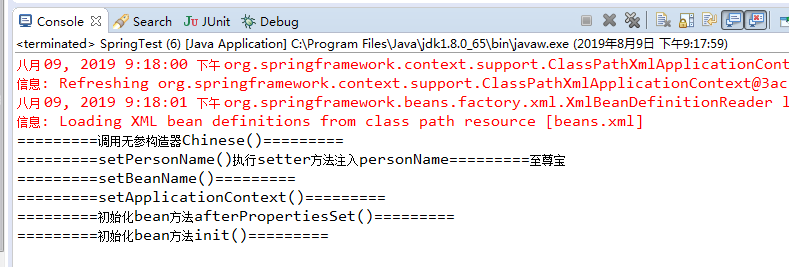1、容器中的bean的生命周期
spring容器可以管理singleton作用域的bean的生命周期,包括bean何时被创建、何时初始化完成、何时被销毁。客户端代码不能控制该类型bean的销毁。spring容器可以管理该类型bean在实例化结束之后和销毁之前的行为。
prototype作用域类型的bean则完全交由客户端代码管理,spring容器仅仅是负责创建bean。spring容器无法管理该类型的bean。
管理bean的生命周期行为的主要时机有以下两个:
1》注入依赖关系之后
2》即将销毁bean之前
2、依赖关系注入之后的行为
spring提供两种方式在bean全部属性设置成功后执行特定的行为:
1》使用init-method属性,指定某方法在在bean全部属性(即包括依赖)设置成功后执行特定行为。
2》实现InitializingBean接口,并实现该接口的void afterPropertiesSet() throws Exception方法。
举个例子:

Chinese.java
package com.lfy.bean;
import org.springframework.beans.BeansException;
import org.springframework.beans.factory.BeanNameAware;
import org.springframework.beans.factory.InitializingBean;
import org.springframework.context.ApplicationContext;
import org.springframework.context.ApplicationContextAware; public class Chinese implements InitializingBean,BeanNameAware,ApplicationContextAware { private ApplicationContext ctx; private String beanName; private String personName; public Chinese() { System.out.println("=========调用无参构造器Chinese()========="); } @Override public void setBeanName(String beanName) { this.beanName=beanName; System.out.println("=========setBeanName()========="); } @Override public void setApplicationContext(ApplicationContext arg0) throws BeansException { this.ctx=arg0; System.out.println("=========setApplicationContext()========="); } /** * 生命周期方法 */ @Override public void afterPropertiesSet() throws Exception { System.out.println("=========初始化bean方法afterPropertiesSet()========="); } /** * 将被设为生命周期方法 */ public void init() { System.out.println("=========初始化bean方法init()========="); } public void setPersonName(String name) { this.personName=name; System.out.println("=========setPersonName()执行setter方法注入personName========="+personName); } public void info() { System.out.println("Chinese实现类"+",部署该bean时指定的id为:"+beanName); } }
beans.xml
<?xml version="1.0" encoding="UTF-8"?>
<!-- spring配置文件的根元素,使用spring-beans-4.0.xsd语义约束 -->
<beans xmlns:xsi="http://www.w3.org/2001/XMLSchema-instance"
xmlns="http://www.springframework.org/schema/beans"
xsi:schemaLocation="http://www.springframework.org/schema/beans
http://www.springframework.org/schema/beans/spring-beans-4.0.xsd">
<bean id="chinese" class="com.lfy.bean.Chinese" init-method="init">
<property name="personName" value="至尊宝"/>
</bean>
</beans>
SpringTest.java
package com.lfy.main;
import org.springframework.context.ApplicationContext;
import org.springframework.context.support.ClassPathXmlApplicationContext;
import com.lfy.bean.Chinese;
/**
* 获得bean本身的id
* @author lfy
*
*/
public class SpringTest {
public static void main(String[] args) { ApplicationContext ctx=new ClassPathXmlApplicationContext("beans.xml"); Chinese chin=ctx.getBean("chinese", Chinese.class); } }
运行结果:

总结:上面的例子,两种方式都同时实现了,注意它们执行的顺序。afterPropertiesSet()方法先于init()方法得到执行。
3、bean销毁之前的行为
spring提供两种方式在bean实例销毁之前执行特定的行为:
1》使用destroy-method属性,指定某方法在在bean实例销毁之前执行特定行为。
2》实现DisposableBean接口,并实现该接口的void destroy() throws Exception方法。
举个例子:对前面的例子做一些修改
Chinese.java
package com.lfy.bean;
import org.springframework.beans.BeansException;
import org.springframework.beans.factory.BeanNameAware;
import org.springframework.beans.factory.DisposableBean;
import org.springframework.beans.factory.InitializingBean;
import org.springframework.context.ApplicationContext; import org.springframework.context.ApplicationContextAware; public class Chinese implements InitializingBean,DisposableBean,BeanNameAware,ApplicationContextAware { private ApplicationContext ctx; private String beanName; private String personName; public Chinese() { System.out.println("=========调用无参构造器Chinese()========="); } @Override public void setBeanName(String beanName) { this.beanName=beanName; System.out.println("=========setBeanName()========="); } @Override public void setApplicationContext(ApplicationContext arg0) throws BeansException { this.ctx=arg0; System.out.println("=========setApplicationContext()========="); } /** * 生命周期方法 */ @Override public void afterPropertiesSet() throws Exception { System.out.println("=========初始化bean方法afterPropertiesSet()========="); } /** * 将被设为生命周期方法 */ public void init() { System.out.println("=========初始化bean方法init()========="); } /** * 生命周期方法 */ @Override public void destroy() throws Exception { System.out.println("=========结束bean前执行方法destroy()========="); } /** * 将被设为生命周期方法 */ public void close() { System.out.println("=========结束bean前执行方法close()========="); } public void setPersonName(String name) { this.personName=name; System.out.println("=========setPersonName()执行setter方法注入personName========="+personName); } public void info() { System.out.println("Chinese实现类"+",部署该bean时指定的id为:"+beanName); } }
beans.xml
<?xml version="1.0" encoding="UTF-8"?>
<!-- spring配置文件的根元素,使用spring-beans-4.0.xsd语义约束 -->
<beans xmlns:xsi="http://www.w3.org/2001/XMLSchema-instance"
xmlns="http://www.springframework.org/schema/beans"
xsi:schemaLocation="http://www.springframework.org/schema/beans
http://www.springframework.org/schema/beans/spring-beans-4.0.xsd">
<!-- 遇到了个问题,偶尔出现destory-method="close"不能出现在<bean.../>,暂未明白原因 -->
<bean id="chinese" class="com.lfy.bean.Chinese" init-method="init" destory-method="close">
<property name="personName" value="至尊宝"/>
</bean>
</beans>
SpringTest.java
package com.lfy.main;
import org.springframework.context.support.AbstractApplicationContext;
import org.springframework.context.support.ClassPathXmlApplicationContext;
import com.lfy.bean.Chinese;
/**
* 获得bean本身的id
* @author lfy
*
*/
public class SpringTest {
public static void main(String[] args) { AbstractApplicationContext ctx=new ClassPathXmlApplicationContext("beans.xml"); Chinese chin=ctx.getBean("chinese", Chinese.class); ctx.registerShutdownHook(); } }
运行结果:

总结:由于xml解析发生了些问题未能找到原因,一开始destory-method方法没能演示效果。后来突然又好了,可能是eclipse的问题。在非Web应用上,使用registerShutdownHook()能够正确的关闭spring容器。并且注意destory()方法先于close()方法执行。
4、此外协调作用域不同步的bean:
singleton作用域的bean依赖于prototype作用域的bean,但singleton bean只有一次初始化的机会,在初始化单例bean的时候,会先创建prototype作用域的bean,然后再初始化单例bean。这将导致以后无论什么时候通过单例bean访问prototype bean都会是同一个bean,相当于单例bean变相的将prototype bean单例化了。
为了解决这种生命周期与预期不同步的问题,有两种解决思路:
1》 放弃依赖注入:单例bean每次需要prototype bean时,主动向容器请求新的bean实例。
2》利用方法注入:通常使用lookup方法注入。使用lookup方法注入可以让spring容器重写容器中bean的抽象或者具体方法,返回查找容器中其他bean的结果。spring通过使用JDK动态代理或cglib库修改客户端的二进制代码,从而实现上述需求。
使用lookup方法注入,大致的步骤有:
1》将调用者bean的实现类定义为抽象类,并定义一个抽象方法来获取被依赖的bean。
2》在<bean.../>元素中添加<lookup-method.../>子元素让spring为调用者bean的实现类实现指定的抽象方法。
3》使用<lookup-method.../>元素需要指定如下两个元素:
name:指定需要让spring实现的方法。
bean:指定spring实现该方法的返回值。
举个例子:

Dog.java
package com.lfy.bean;
public interface Dog {
public String run();
}
GunDog.java
package com.lfy.impl;
import com.lfy.bean.Dog;
public class GunDog implements Dog {
private String name;
public void setName(String name) {
this.name=name; } @Override public String run() { return "我是一只叫"+this.name+"的猎犬,奔跑迅速..."; } }
Chinese.java
package com.lfy.bean;
public abstract class Chinese {
//private Dog dog;留作动态注入一个Dog的实例
// 定义抽象方法,该方法用于获取被依赖的bean
public abstract Dog getDog();
public void hunt() {
System.out.println("我带着:"+getDog()+"出去打猎");
System.out.println(getDog().run());
}
}
beans.xml
<?xml version="1.0" encoding="UTF-8"?>
<!-- spring配置文件的根元素,使用spring-beans-4.0.xsd语义约束 -->
<beans xmlns:xsi="http://www.w3.org/2001/XMLSchema-instance"
xmlns="http://www.springframework.org/schema/beans"
xsi:schemaLocation="http://www.springframework.org/schema/beans
http://www.springframework.org/schema/beans/spring-beans-4.0.xsd">
<!-- chinese依赖于gunDog,并且为单例bean依赖prototype实例。
spring检测到lookup-method元素,会自动为该元素的name属性
指定的方法提供实现体
-->
<bean id="chinese" class="com.lfy.bean.Chinese">
<lookup-method name="getDog" bean="gunDog"/>
</bean>
<!-- 指定bean的作用域为prototype,希望每次都是新的bean -->
<bean id="gunDog" class="com.lfy.impl.GunDog" scope="prototype">
<property name="name" value="旺财"/>
</bean>
</beans>
SpringTest.java
package com.lfy.main;
import org.springframework.context.ApplicationContext;
import org.springframework.context.support.AbstractApplicationContext;
import org.springframework.context.support.ClassPathXmlApplicationContext;
import com.lfy.bean.Chinese;
/**
* 获得bean本身的id
* @author lfy
*
*/
public class SpringTest { public static void main(String[] args) { ApplicationContext ctx=new ClassPathXmlApplicationContext("beans.xml"); Chinese p1=ctx.getBean("chinese", Chinese.class); Chinese p2=ctx.getBean("chinese", Chinese.class); System.out.println("是否还是同一个Chinese猎人:"+(p1 == p2)); p1.hunt(); p2.hunt(); } }
运行结果:

总结:我们的Chinese类是一个抽象类,它不能实例化。我们通过给它添加<lookup-method.../>元素,告诉spring需要实现哪个抽象方法spring容器为抽象方法提供实体后,抽象方法变成类的具体方法,这个类也就变成了具体类,接下来spring就可以创建该bean的实例了。
spring会采用运行时动态增强的方式来实现<lookup-method.../>元素所指定的抽象方法:如果目标抽象类实现过接口,spring会采用JDK动态代理来实现该抽象类,并为之实现抽象方法;如果目标抽象类没有实现过接口,spring会采用cglib实现该抽象类,并为之实现抽象方法。spring-4.0.4已经在核心包中集成了cglib类库,无需额外添加cglib的jar包。